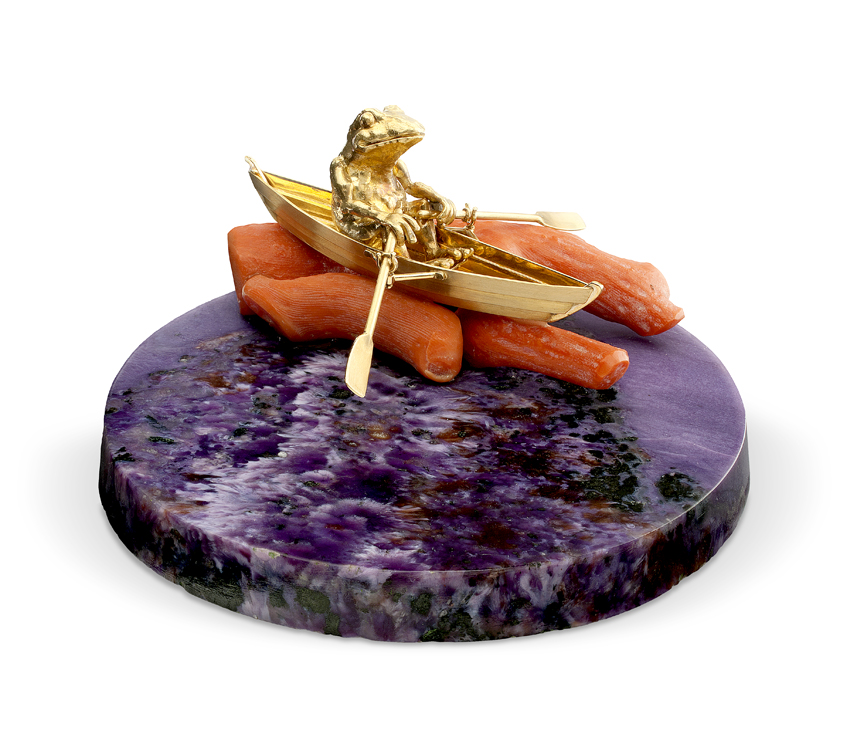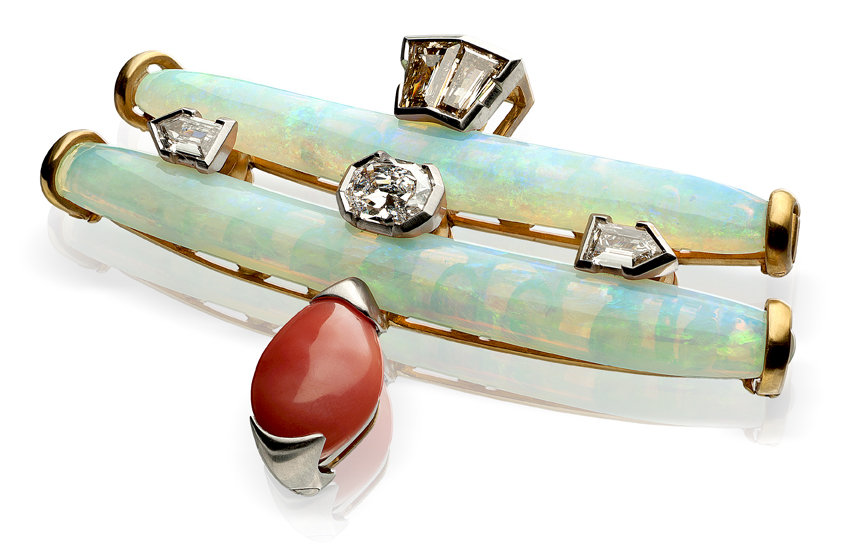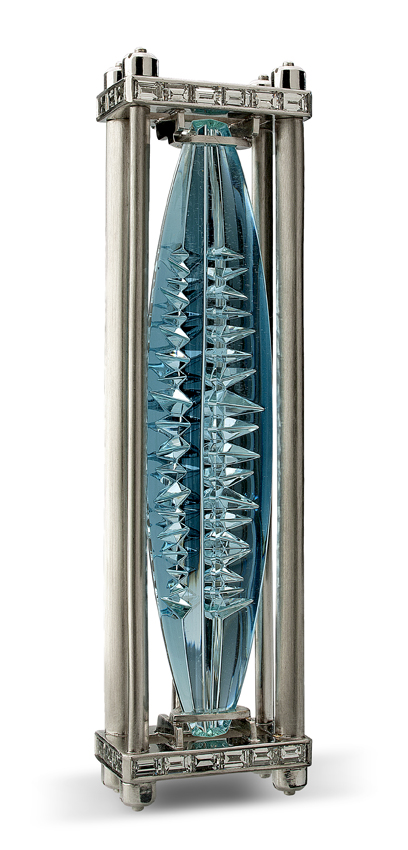It is no accident that the name Enrico Cirio is not as popular as the famous and well-known jewellery Maison.
Extroverted, willing to know people, their characters and personalities, lover of cultured conversation, Cirio preferred to know and meet with interesting people, with something to offer from a human and cultural point of view. He avoided social events and media, leaving his creations, expressions of his personality, at the centre of the scene.
Having art in his veins, Enrico was born in Turin on 14 November 1932 in his grandfather’s laboratory. Within his family and thanks to the ancient Turin goldsmith school “E.G. Ghirardi”, Cirio learned the secrets of goldsmith’s world. His training was versatile; the aviation school was fundamental, giving him the notions of mechanics, metallurgy and chemistry that characterized his works in an extremely original way.
For all his life, until the end (he died in Turin in 2007), his energy was expressed also through his wide cultural interests, going from figurative art to mechanics, and from philosophy to the study of foreign languages such as ancient Greek, Arabic and Chinese.
Creative and with an uncontainable imagination, Cirio soon abandoned his father’s laboratory to take up his own innovative path, based on research; a never-ending cultural, stylistic and material experimentation research, lively reflex of his curiosity. In the meantime, he studied figurative arts, worked as designer and painter, and had contacts with the most important representatives of contemporary art and avant-garde architecture, with whom he cooperated to realize real works of goldsmith’s art with citations of Abstractionism, Minimalism, Pop Art, Arte Povera and Conceptual Art.
For all his life he drew freehand, with the pencil running mad on papers, never attracted by the new technological systems such as CAD or by the processes of industrial production, completely far from his way of thinking and working. For Cirio, jewels were creations born from hours of study and projects, followed by an execution with maniacal perfection in which each stage of the manufacturing was personally followed by him and when the result was not satisfactory, he unmade everything and started over. His perseverance, supported by relevant skills and technical expertise, defied daring projects and incredible problems of execution, up to the resolution of any difficulty. Before satisfying the client, his jewel had to satisfy the most rigid of all critics, himself.
He could draw a jewel on the spot, inspired by the personality of the client, or spending hours in front of a table and in his laboratory, maybe at night, when, he immediately drew sudden ideas and inspirations. Cirio had no distinctions between work and private life, his home was his laboratory, and jewellery was his existence; that’s why each creation is a unique piece. Each jewel expresses the passion for his job-life, his inspiration connected to a precise moment and impossible to be reproduced serially. Each object was then told by a story or tale, written by him, which represented the narration of the meaning of that jewel: a microcosm in a jewel-architecture-sculpture.
The cases of his creations had to be special too, in tune with their content. And these were designed by himself too.
Nature, animals, architecture, people he met, journeys... everything was a source of inspiration. And all materials could be part of his creations: extremely valuable gems personally chosen during his journeys all over the world; noble metals together with poor materials such as wood, glass, leather or lava; even the steel wool to clean dishes could be used as a nest for kunzites or emeralds. Materials with a new life and unthinkable aspects, transformed according to his expressive will, through manual manipulation. Physical contact, feeling the materials in his hands – the tactility – were integrant part of his creative process. He seemed to dialogue with gems and materials in order to extract what he considered their essence; materials and surprising and unusual matching, especially in the years between the 1960s and 1990s, period of his most original and fertile production.
I remember the surprise I felt at the beginning of my cooperation as gemologist with Cirio. Provocative and ironic, he defied me continuously to identify the materials he used, which were clearly not included in the studies of a gemologist.
He had a profound knowledge of gems: chemical and physical properties, mines and countries of origin were for him as important as specifications and aesthetic values. But also with them, Cirio was extremely demanding. Their choice was never dominated by the taste of the moment or the dictates of the market. He always looked for a marriage between technical properties and emotional suggestions which represents the clear mark of his works.
And therefore, for example, he used titanite (or sphene) – gem usually connected with collectors’ world – as protagonist of his shining fire in some of his brooches-sculptures.
Extremely fond of pearls, especially natural, he always looked for the most fascinating and rare ones because of their shape or colour. I recall his large collection of extremely rare Strombus gigas pearls (a Caribbean gasteropod) or Haliotis pearls, with metallic brightness.
Each gem, included diamonds, had to provoke an emotion and wonder, perfect also in the cut. A particular cut, carried out perfectly or imaginatively, could attract his creativity, and no matter if, to reach the result he had in his mind, he lost a huge part of the weight of the original rough gem. That’s why he frequently used the works of the German Bernd Munsteiner, cutter, or better, designer of gems internationally known, inventor and performer of original geometrical shapes that perfectly fit Cirio’s tastes.
His originality was expressed also in the titles of his works: Perfectly disordered star, Long-limbed cactus bright thorns, Trap for water drops, Shadow of the shadow of a building never existed and thought, Igloo for a wealthy snail, Abalone (Haliotis) is not an insult, just to name some of them, from which it is possible to understand his deglamourizing irony, the elaboration of his idea and the manifestation of his mental path.
Demanding and fussy, quick-tempered and sometimes prone to anger, convivial and quick on the draw, with a provocative and ironic nature, profoundly Italian and original, Enrico Cirio looked only like himself, with no commercial compromises; you can love him or hate him, but for sure no-one might ever deny his complex culture and his uniqueness.
In order to preserve his lesson of love and passion for work, for study and research, his wife Anna – who continues the activity of the Maison – dedicated him the Cirio Museum (www.ciriomuseum.com) and the talent award “Materia e Movimento” for young designers.
Extroverted, willing to know people, their characters and personalities, lover of cultured conversation, Cirio preferred to know and meet with interesting people, with something to offer from a human and cultural point of view. He avoided social events and media, leaving his creations, expressions of his personality, at the centre of the scene.
Having art in his veins, Enrico was born in Turin on 14 November 1932 in his grandfather’s laboratory. Within his family and thanks to the ancient Turin goldsmith school “E.G. Ghirardi”, Cirio learned the secrets of goldsmith’s world. His training was versatile; the aviation school was fundamental, giving him the notions of mechanics, metallurgy and chemistry that characterized his works in an extremely original way.
For all his life, until the end (he died in Turin in 2007), his energy was expressed also through his wide cultural interests, going from figurative art to mechanics, and from philosophy to the study of foreign languages such as ancient Greek, Arabic and Chinese.
Creative and with an uncontainable imagination, Cirio soon abandoned his father’s laboratory to take up his own innovative path, based on research; a never-ending cultural, stylistic and material experimentation research, lively reflex of his curiosity. In the meantime, he studied figurative arts, worked as designer and painter, and had contacts with the most important representatives of contemporary art and avant-garde architecture, with whom he cooperated to realize real works of goldsmith’s art with citations of Abstractionism, Minimalism, Pop Art, Arte Povera and Conceptual Art.
For all his life he drew freehand, with the pencil running mad on papers, never attracted by the new technological systems such as CAD or by the processes of industrial production, completely far from his way of thinking and working. For Cirio, jewels were creations born from hours of study and projects, followed by an execution with maniacal perfection in which each stage of the manufacturing was personally followed by him and when the result was not satisfactory, he unmade everything and started over. His perseverance, supported by relevant skills and technical expertise, defied daring projects and incredible problems of execution, up to the resolution of any difficulty. Before satisfying the client, his jewel had to satisfy the most rigid of all critics, himself.
He could draw a jewel on the spot, inspired by the personality of the client, or spending hours in front of a table and in his laboratory, maybe at night, when, he immediately drew sudden ideas and inspirations. Cirio had no distinctions between work and private life, his home was his laboratory, and jewellery was his existence; that’s why each creation is a unique piece. Each jewel expresses the passion for his job-life, his inspiration connected to a precise moment and impossible to be reproduced serially. Each object was then told by a story or tale, written by him, which represented the narration of the meaning of that jewel: a microcosm in a jewel-architecture-sculpture.
The cases of his creations had to be special too, in tune with their content. And these were designed by himself too.
Nature, animals, architecture, people he met, journeys... everything was a source of inspiration. And all materials could be part of his creations: extremely valuable gems personally chosen during his journeys all over the world; noble metals together with poor materials such as wood, glass, leather or lava; even the steel wool to clean dishes could be used as a nest for kunzites or emeralds. Materials with a new life and unthinkable aspects, transformed according to his expressive will, through manual manipulation. Physical contact, feeling the materials in his hands – the tactility – were integrant part of his creative process. He seemed to dialogue with gems and materials in order to extract what he considered their essence; materials and surprising and unusual matching, especially in the years between the 1960s and 1990s, period of his most original and fertile production.
I remember the surprise I felt at the beginning of my cooperation as gemologist with Cirio. Provocative and ironic, he defied me continuously to identify the materials he used, which were clearly not included in the studies of a gemologist.
He had a profound knowledge of gems: chemical and physical properties, mines and countries of origin were for him as important as specifications and aesthetic values. But also with them, Cirio was extremely demanding. Their choice was never dominated by the taste of the moment or the dictates of the market. He always looked for a marriage between technical properties and emotional suggestions which represents the clear mark of his works.
And therefore, for example, he used titanite (or sphene) – gem usually connected with collectors’ world – as protagonist of his shining fire in some of his brooches-sculptures.
Extremely fond of pearls, especially natural, he always looked for the most fascinating and rare ones because of their shape or colour. I recall his large collection of extremely rare Strombus gigas pearls (a Caribbean gasteropod) or Haliotis pearls, with metallic brightness.
Each gem, included diamonds, had to provoke an emotion and wonder, perfect also in the cut. A particular cut, carried out perfectly or imaginatively, could attract his creativity, and no matter if, to reach the result he had in his mind, he lost a huge part of the weight of the original rough gem. That’s why he frequently used the works of the German Bernd Munsteiner, cutter, or better, designer of gems internationally known, inventor and performer of original geometrical shapes that perfectly fit Cirio’s tastes.
His originality was expressed also in the titles of his works: Perfectly disordered star, Long-limbed cactus bright thorns, Trap for water drops, Shadow of the shadow of a building never existed and thought, Igloo for a wealthy snail, Abalone (Haliotis) is not an insult, just to name some of them, from which it is possible to understand his deglamourizing irony, the elaboration of his idea and the manifestation of his mental path.
Demanding and fussy, quick-tempered and sometimes prone to anger, convivial and quick on the draw, with a provocative and ironic nature, profoundly Italian and original, Enrico Cirio looked only like himself, with no commercial compromises; you can love him or hate him, but for sure no-one might ever deny his complex culture and his uniqueness.
In order to preserve his lesson of love and passion for work, for study and research, his wife Anna – who continues the activity of the Maison – dedicated him the Cirio Museum (www.ciriomuseum.com) and the talent award “Materia e Movimento” for young designers.


